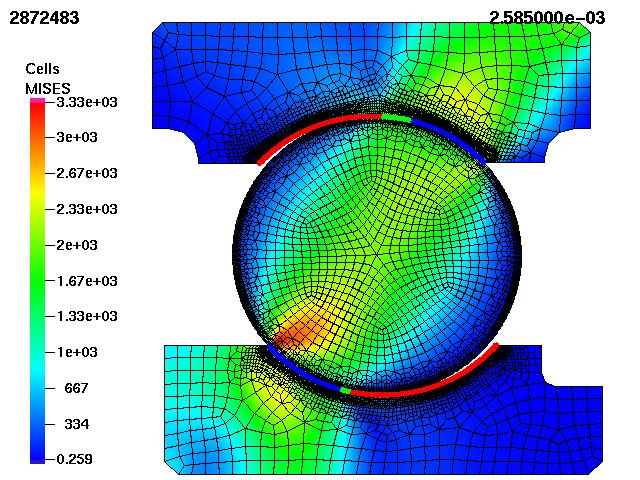 |
Coupling system dynamics and local contact behaviour Actual mechanical
systems include surfaces in sliding contact that are subjected to wear if
exposed to large vibration. In fact, the vibration of components in contact
results in large oscillations of the local contact stresses, due to the local
deformation of the components at the contact interfaces. Vice-versa
the local contact behaviour affects largely the system dynamics. An
interdisciplinary approach is need to handle dynamic and tribological
problems.
|
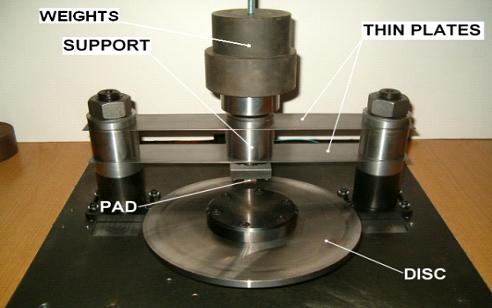 |
Brake Squeal Noise and Vibrations
Between
the NVH issues,
brake squeal is an acoustic emission caused by vibration induced by
friction
forces, occurring on the frequency range between 1 and 20 KHz. The
research project approaches the problem coupling tribological and
dynamic analyses, by experimental and numerical investigations. Effects
of system parameters such as damping, and passive solutions such as
structural modifications are investigated. A new approach including system uncertanties is proposed as well. |
 |
Tactile perception
Fingers are moved to scan the object surfaces
generating skin vibrations. The information on object surfaces is contained in
the friction induced vibrations. The mechanoreceptors, mechanical sensors immersed
into the skin, have the key role of transducing the stress state oscillations into
electrical impulses conveyed to the brain. It is needed to develop
appropriate investigations to link the vibration spectra generated by the finger
scanning with the tactile sense.
|
|
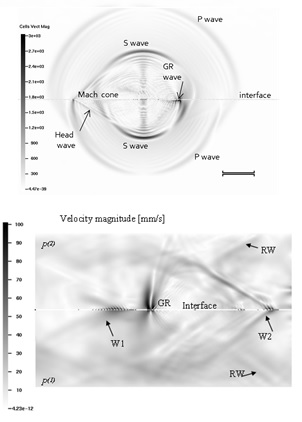
|
Wave propagation at contact interfaces
Friction is a stiff phenomenon, depending on several parameters and affecting system behavior.
At the frictional contact the relative motion gives rise to local ruptures and waves
which propagate at the interface. An understanding of wave propagation and generation
at the contact is fundamental for understanding friction induced vibrations and the macroscopic
frictional behaviors (local and macroscopic stick-slip, continuous sliding, ...) at the
origin of several phenomena such as earthquakes or surface machining damages.
|
|
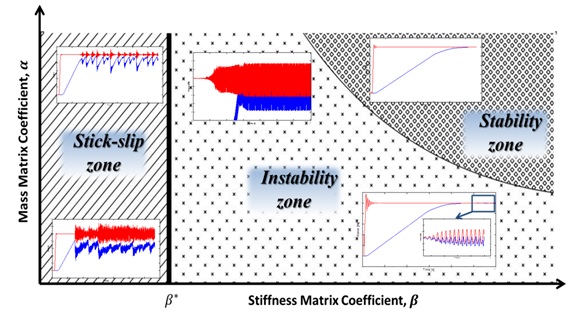
|
Maps of contact instability scenarios
Phenomena rising when two body are in frictional contact
like stick-slip, fatigue failures, self-excited vibrations,
are substantial subject of interest in different domains, such as nonlinear dynamics,
tribology, biomechanics, or geophysics. The aim of this project is to investigate the
instability scenarios occurring when friction forces excite the mechanical systems during
the relative motion; the coupling between the frictional behaviour at the contact and the global dynamic of
the system bring to either stick-slip phenomena, or modal instabilities.
|
|
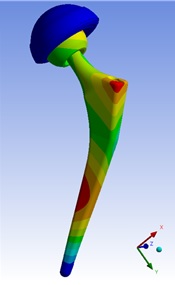
|
Hip endoprosthesis Squeaking noise emission
The ceramic-on-ceramic bearings are characterized by low wear rates and an excellent
biocompatibility. Nevertheless, recent worrisome rates of squeaking noise occurrence
are reported for this kind of prosthesis. The aim of this project is the development and validation
of a numerical model able to predict the friction induced vibrations at the origin of the squeaking noise
emission. The model allows as well for recovering the same in-vivo squeaking frequencies and for comparing
squeaking propensity of different prosthesis designs.
|
|

|
Energy transfer between acoustic fields by frictional contacts for passive structural monitoring
The friction nonlinearity between sliding surfaces can be
used to transfer vibrational energy between acoustic fields,
by the dynamic response of the solids in contact. The energy transfer
can be useful for several applications such as passive health monitoring and
diagnostic, recovering of environmental vibrational energy, etc.
Numerical and experimental analyses are used to develop a
mechanical system able to transfer energy between the wished acoustic fields.
|
|
![]()
|
Analysis of degradation scenarios of high loaded oscillating bearings
This project addresses the analysis of the degradation mechanism
of oscillating ball bearings subjected to high loads. These bearings can
reach extreme contact pressures at the ball-race contact surfaces; the oscillation
of the bearings provides fatigue loading of the contact area due to the repetitive
rotation of the balls between the races. A numerical plastic model with contact nonlinearities
and experimental tribological observations are developed to highlight
the degradation scenarios and to prevent/predict the bearing failure.
|
|
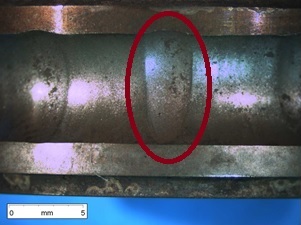
|
False Brinelling degradation of bearings exposed to vibrational environment
This project deals with the numerical analysis aimed
to reproduce the behavior of the local contact stresses between
balls and raceways of the rolling bearings used into bleed valves of aircrafts. The scenario
of the false Brinelling degradation of the race surfaces is investigated.
A multi-body nonlinear model is developed to account for the vibrational
excitation from the engines and the dynamic response of the bleed valve. The
forces acting on the bearings are then introduced in a finite element model by the code PLASD2,
in order to recover the stress distribution at the contact. The stress values at the nucleation zones
of the false Brinelling degradation are recovered numerically.
|
| | Energy balance of a frictional contact: contact damping and friction induced vibrations
One of the research branches the most investigated
lies in the field of non-linear dynamics and deals with the vibration
damping by frictional contact. A more general approach accounting for the
energy transfer between surface and solid dynamics is needed to identify the energy
effectively dissipated at the contact and the energy reintroduced in the system by friction
induced vibrations. To allow this distinction, a main attention is addressed to
the energy balance and a correct analysis of the energy flows.
energy, etc.
|
| | Coupling mechanism, first bodies and third body scales of the tribological triplet The
tribological triplet (mechanism, first bodies, third body) is the
framework of every contact issue. Different spatial and time scales
intervene in the phenomenon. While several numerical methods deal with
the different scales separately, a global approach is still unknown.
The project aims to propose a coupling of numercal methods (FEM, DEM,
...) dealing with the different scales, for a more accurate modeling of
contact issues.
|